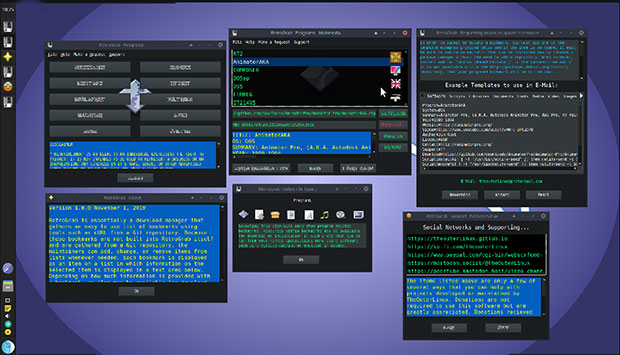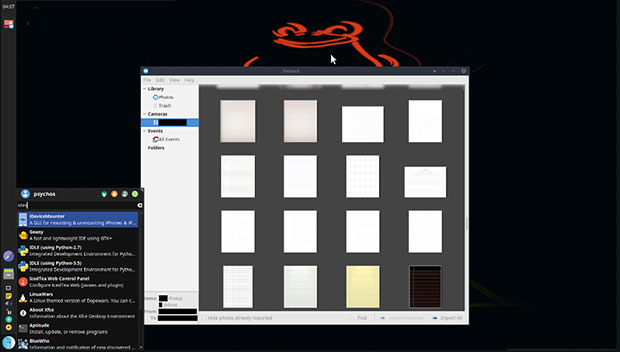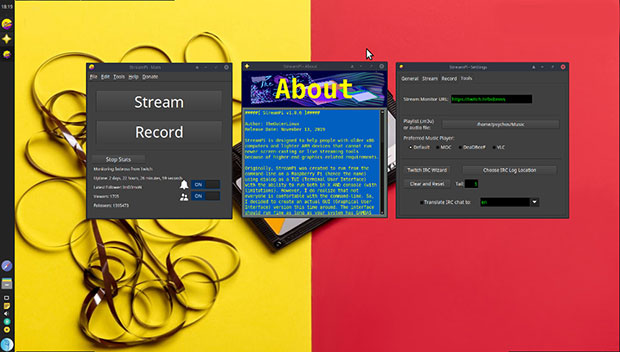One of the great joys of constantly checking out new or obscure Linux operating systems is finding some insane innovations that stand out from the crowded collection of distros. The current release of PsychOS Linux, code-named “Insane,” possibly might blow your mind.
This distro is really an off-the-wall project with the potential to become a thing unto itself. PsychOS is a systemd-free, GNU/Linux operating system based on Devuan ASCII — a fork of Debian Linux.
PsychOS Linux is a strange duck in the Linux distro world. It is very retro-esque.
However, even if you consider yourself a retrophile, PsychOS may not be for you. It was developed for older hardware and is available only for 32-bit computers. The developer has no immediate plans to release a 64-bit version.
However, there is a workaround. If you are interested in checking it out, you can run it in a virtual box with 32-bit settings.
Many Linux devs are dropping 32-bit releases, so even though PsychOS is not a mainstream product, it can keep aging hardware productive.
PsychOS is polished in that it runs well. It is interesting in that it is clearly unlike the look and feel of today’s top-of-the-line Linux distributions.
Free With a Catch
This distro is packed with software and scripts for an easier, out-of-the-box user experience. It is open source but has a special license. Free use is permitted, but there are restrictions on changing and redistributing without removing the non-free software contributed by the developer’s company, TheOuterLinux.
This means that the PsychOS distribution itself is currently licensed under GPLv3. You may share copies of PsychOS in its entirety with your friends and family. However, PsychOS contains non-free software — like most GNU/Linux distributions — so you do so at your own risk.
For computer users familiar with computing nostalgia, it is easy to see how this developer’s interest in retro influenced the design of PsychOS Linux. The developer has a long history of exclusively using GNU/Linux and DOS, or Disk Operating System.
The developer sees both as legitimate desktop options. Although many in the industry seem to prefer that only Linux be used for web development and mobile phones, leaving older operating systems for amusement, mostly retro gaming.
The Unknown Dev
For privacy reasons, both the distribution and the software company are managed by the same individual, known online as “TheOuterLinux. ” During my email exchanges, this developer remained adamant about not divulging personal information.
The person asserted that the working environment in the GNU/Linux and other Linux communities is sufficient, and the media does not need to know about the developer’s identity.
“I hope this doesn’t come across as rude, but I have zero plans of ever volunteering ANY personal information about myself that involves any real names, locations, genders, and other potential biometrics-related information, TheOuterLinux developer told LinuxInsider.
This developer believes such information is irrelevant, as “people within tech circles that volunteer their time should be known by their work.”
That personal privacy attitude has made conducting Linux-related business challenging, the distro developer admitted. “Practicing what I preach has made it MUCH harder to get proper support, such as donations for future projects, since you cannot expect people to give money to ‘strangers.'”
Retro Revival and More
Retro comes alive in PsychOS and is the main driving point in its development. The distro creator still uses DOS software, launched easily from the applications menu via emulators such as DOSBox.
The developer noted that anyone with PsychOS 3.4.6 and higher who uses RetroGrab to install older software can do the same. The corresponding emulators must be installed first. PsychOS also lets you run more than one DOS program at a time.
PsychOS uses the RetroGrab download manager to collect a list of bookmarked items using tools like cURL.
Other programming influences include BASIC and BBC BASIC, due to shortcomings that helped the PsychOS developer learn more about Python. Other BASIC flavors are FreeBASIC, QB45, and QB64.
BASH scripting is a favorite way to put this developer “ahead of the game” for most existing UNIX/Linux operating systems. JAVA is out of the picture because it is too cumbersome.
“I’m old school and prefer that people use languages such as C, C++, Pascal, Python, and BASIC,” the developer said. “I like retro, old school, Luddite things and wanted to bring that sort of feeling to people while they use PsychOS. I like GTK, FLTK, X, and other ‘keep it simple stupid’ user interfaces.”
Widespread Recognition the Goal
PsychOS development began around October 2015. Technically, the first public release was version 2.6.1, but the creator never bothered to inform DistroWatch until PsychOS 3.4.6, the current release.
DistroWatch tracks Linux distribution releases and news about hit rankings, and general information about various other free software/open-source Unix-like operating systems. It has a waiting list and certification process for new additions to its website.
PsychOS applied for placement on the waiting list on Jan. 11.
Releasing a 64-bit version would increase its chances of becoming more widely used, but the developer’s initial passion is to provide a solid Linux OS for use on older computers. When the developer does focus on a 64-bit version, it no doubt will be ARM-based.
A 64-bit version would have less included out-of-the-box because most are larger than their 32-bit versions when installed, according to the developer. One of PsychOS’ major points is to assume that a person always will have access to the Internet to add more software to get work done. So a 64-bit version may not be possible or simply may be counterintuitive.
Planning Ahead
The PsychOS developer is working on a version that might be called PsychOS486 for i486 software and plans to create a FreeDOS version and call it “PsychDOS.” “Essentially, I’m going backward instead of forwards because no one else seems to be doing it, and I believe that the window of opportunity for this is closing fast.”
The assumption is that in five to 10 years, the competing distros will no longer be worth using. Many older GNU/Linux distributions include repository information that is obsolete. Either the software repositories are missing, or cannot be corrected due to SSL-related issues.
“I would really like to get through my i486 (PsychOS486) and DOS (PsychDOS; FreeDOS-based) versions first before even thinking about (creating a 64-bit version of PsychOS), as 64-bit packages and systems are in no immediate danger,” the developer said.
PsychOS Unwrapped
Artists, gamers, and software hoarders will find a lot to love running PsychOS Linux. It is the definition of a multipurpose Linux distribution. Developers are also served well.
The ISO is a live session, so you can run it by rebooting your computer without installing a hard drive. You can also burn the ISO to a USB drive or a blank DVD.
However, be sure to select a large-capacity USB. It is a large installation loaded with lots of applications. You get several titles to do the same type of job.
That is great if you lack the time or the Internet connection to search for alternative software once you install this distro. In fact, you get a complete desktop operating system with all you need, with slow or nonexistent Internet connections.
Software Rundown
You get the LibreOffice suite and the AbiWord/Gnumeric combination for office solutions, Pale Moon and Dillo for Web browsing, and tools galore for creativity and the operating system.
Educational software includes Nootka, a program for learning musical notation; Stellarium, an interactive planetarium; BKChem, for creating or viewing chemical objects and formulas; and Reinteract, for interactive experimentation with Python.
PsychOS has tools for importing photos from other devices and platforms. The main menu (lower-left corner) shows applications not usually found bundled in Linux distros.
Multimedia software is equally impressive. That category contains titles I have never seen bundled in other Linux distributions. For instance, you get Aseprite, a sprite editor, Birdfont to edit existing fonts or create your own; Dia, a straightforward diagram editor; and FreeCAD, an alternative to expensive commercial CAD solutions.
The multimedia menu includes dozens of interesting titles, as well as the expected classics, which include GIMP, Inkscape, Krita, Blender, Scribus, and Peek.
The Gaming/Emulation menu caters to retro gamers with some 14 different emulators in addition to ZSNES, Stella, DeSmuME, DOSBox, Kega Fusion, and PCSXR/PCSX2.
Developer tools include fldiff, Godot, Slade, and OHRRPGCE (Official Hamster Republic Role Playing Game Construction Engine). The ISO contains lots of Python-related software, including IDLE as the IDE, available for Python-2.7 and Python-3.5 development.
Modern programmers might prefer other choices, but PsychOS provides a solid foundation for simple old-school programming tasks.
Using the Insane System
PsychOS 3.4.6 uses Xfce as the desktop environment. This is a prime choice from a developer’s viewpoint, and it blends well with resource limitations in 32-bit computers. Xfce is also very configurable and well-suited for modification, which is the reality of the desktop environment in PsychOS.
However, its default layout differs from what you expect from an Xfce implementation elsewhere.
The desktop environment is essentially Xfce with a few more hidden panels than people are used to, according to the PsychOS developer, who wanted to make sure people would understand that there are no limits to what you can do beyond your imagination when it comes to your desktop.
If they’re bothersome, they are easy to remove. “I just want to put the fun back into GNU/Linux like it used to be and let people know that it isn’t just for servers,” the developer said.
Here are some things I discovered about using this distro’s tweaked desktop environment:
- The Wi-Fi does work, but it is disabled by default. Right-click the Network Manager applet icon in the Notifications area of the main panel. Then select “Enable Wi-Fi.”
Why disable it by default? The developer does not believe a computer should send out unnecessary radio signals when the Internet of Things and mobile devices are becoming increasingly creepy.
- Bluetooth works unless your system lacks Bluetooth capability. The logic behind disabling Bluetooth by default is the same as for Wi-Fi.
Run the “Enable Bluetooth” item located in the applications menu to remove a Bluetooth kernel module from the blacklist. Do this at each reboot.
More Oddities
PsychOS Insane mixes in some abnormal design factors that make it crazy good. It’s very functional.
For example, the developer feels more is much better than less and follows through on that philosophy with software choices. This is also evident in the choice of package management system. You get multiple software installation/removal options besides manual, as in the command line.
Why? The simple answer is “options,” according to TheOuterLinux dev. “I believe that it is better to have and not need than to need and not have — but I am also a program hoarder, if anyone can tell.”
There is a practical reason, though. The manual installation, such as an application menu item labeled “Install NetRunner,” is provided because some software cannot legally be included in a distribution or the developer tried to contact the developer(s), and no one responded.
“So it is essentially a perfectly legal workaround. A lot of out-of-the-box GNU/Linux distributions do this for things such as Adobe Flash and Nvidia,” noted the dev.
Consider the folder with older Firefox or Palemoon add-ons included. Because Palemoon is currently licensed, you can redistribute It, but you cannot set it up ahead of time.
“They have a webpage for obtaining add-ons, but many of the ones people like, such as NoScript and uBlock Origin, disappeared a long time ago for some reason, and I just wanted to be sure that people have options and hopefully use them to protect themselves,” said the PsychOS developer.
Design Matters
TheOuterLinux designed the distro and its inner workings with an eye on usability. People new to GNU/Linux typically see GNOME 3 or higher, KDE Plasma, or Pantheon. Those desktop choices are boring and use an excessive amount of RAM for what little customization they offer without having to install extra things.
PsychOS comes with custom-developed programs such as StreamPi for live video streaming and screencast recording.
XFCE has stood the test of time and still offers the most bang per byte out of the box compared to most other desktop environments. According to the developer, it offers a default user interface that appeals to most computer users, regardless of operating system familiarity.
PsychOS includes a customized IceWM to make it look “prettier” for those who need even less RAM after logging in. The distro creator explained that you can switch by logging out and then using F2 at the login screen.
“I was actually going to have the IceWM clock use Klingon numbers but decided to let people find that Easter Egg themselves in the ~./icewm folder. Oh, and there is also Kodi as a desktop environment option, so you can comfortably, or more so than normal, log into that using your living room TV and walk away without too much worry about what any small kids might do to any important files while you are gone. I did not pre-setup Kodi in any way,” the developer added.
Be sure to check out the console or terminal window — CLIMax in PsychOS. When you switch to it for the first time using Ctrl+Alt+F1, an ASCII animation plays as sort of a “Welcome to PsychOS.” It then asks if you would like to try CLIMax. As a bonus, you can find command line notes here.
Bottom Line
Do you still have that clunky old 32-bit computer collecting dust in the basement? Do you currently use a 32-bit computer that limps along like molasses sliding down a hill?
It is time to revive your aging computer and make it usable once again running PsychOS. Many Linux distributions are designed to run lean and mean on older computers. PsychOS Linux is specifically tweaked to infuse faster performance — plus, it comes with a huge gold mine of really useful applications.
Just be ready for a wild ride. The screen animations and desktop performance are insane.
Suggest a Review
Is there a Linux software application or distro you’d like to suggest for review? Something you love or would like to get to know?
Email your ideas to me and I’ll consider them for a future column.
And use the Reader Comments feature below to provide your input!


























































